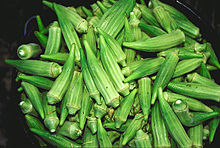Okra: Difference between revisions
| Line 36: | Line 36: | ||
*'''Hindi''': Bhindi |
*'''Hindi''': Bhindi |
||
*'''[[Urdu]]''': Bhindi |
|||
== Distribution == |
== Distribution == |
||
Revision as of 03:38, 30 April 2007
| Abelmoschus esculentus | |
|---|---|

| |
| Okra is an important vegetable around the world | |
| Scientific classification | |
| Kingdom: | |
| Division: | |
| Class: | |
| Order: | |
| Family: | |
| Genus: | |
| Species: | esculentus
|
| Binomial name | |
| Abelmoschus esculentus | |
Abelmoschus esculentus, commonly known as okra or lady's finger, is a flowering plant valued for its edible green fruits. The name okra is of West African origin and is cognate with "ókùrù" in Igbo, a language spoken in what is now known as Nigeria. The species is occasionally referred to by an early, now incorrect synonym, Hibiscus esculentus L.
The species is an annual or perennial, growing to 2 m tall. The leaves are 10–20 cm long and broad, palmately lobed with 5–7 lobes. The flowers are 4–8 cm diameter, with five white to yellow petals, often with a red or purple spot at the base of each petal. The fruit is a capsule, 5–20 cm long, containing numerous seeds.
Vernacular names
- Arabic: بامية , bamiyah
- English: okra, common okra, lady's finger[1][2]
- French: gombo commun, gumbo [1][2]
- Greek: μπάμια, bamia
- Malaysia: bendi
- Persian: باميه, bamiyeh
- Gujarati: bhinda
- Portuguese: quiabeiro [1][2]
- Romanian: bama, bame
- Swahili: mbamia, mbinda [1][2]
- Tamil: vendaikaai
- Turkish: bamya
- Hindi: Bhindi
- Urdu: Bhindi
Distribution
The genus Abelmoschus is naturally distributed across Asia, Africa, and Australia; however, Abelmoschus esculentus is a cultigen of uncertain origin. It is widespread in tropical, subtropical and warm temperate regions, but is particularly popular in West Africa, India, the Philippines, Thailand and Brazil. Abelmoschus esculentus has been reported from the whole of tropical Africa, whereas West African okra (Abelmoschus caillei) is restricted to the humid and perhumid climates of Africa.[1][2]
The species was introduced to the United States via the African slave trade route, and is an annual crop in the southern states.
Uses

Abelmoschus esculentus is cultivated throughout the tropical and warm temperate regions of the world for its fibrous fruits containing round, white seeds. The fruits are harvested when immature and eaten as a vegetable.
In Iran, Egypt, Lebanon, Israel, Jordan, Iraq, Greece, Turkey and other parts of the eastern Mediterranean, okra is widely used in a thick stew made with vegetables and meat. In Indian cooking, it is sauteed or added to gravy-based preparations and is very popular in South India. It became a popular vegetable in Japanese cuisine towards the end of the 20th century, served with soy sauce and katsuobushi or as tempura. It is used as a thickening agent in Charleston gumbo. Breaded, deep fried okra is served in the southern United States. The fruits may be pickled.
The leaves of Abelmoschus esculentus are eaten raw in salads, or cooked as a vegetable.
As part of the Brazilian cuisine, and especially in the region of Minas Gerais, it is much appreciated as a fundamental part of the typical dish frango com quiabo (chicken with okra), consisting on a preparation of this vegetable with chicken parts and specific species, to be then eaten with rice.
Uses in tropical Africa
Young immature fruits are an important vegetable, consumed cooked or fried. In West Africa they are usually boiled in water to make slimy soups and sauces. The fruits can be conserved by drying, whole or sliced, or by pickling. Before selling, the dried product is usually ground to powder. Young leaves are commonly used as spinach. The leaves are sometimes used as cattle feed.[1][2]
Okra mucilage is suitable for medicinal and industrial applications. It has been used as a plasma replacement or blood volume expander. Leaves are sometimes used as a basis for poultices, as an emollient, sudorific or antiscorbutic and to treat dysuria. Okra mucilage has been added as size to glaze paper and is used in confectionery. The bark fibre has been locally used for fishlines and game traps. It is suitable for spinnning into rope and for paper and cardboard manufacture. Roasted okra seeds are used in some areas as a substitute for coffee.[1][2]
Cultivation

Abelmoschus esculentus is among the most heat- and drought-tolerant vegetable species in the world. It will tolerate poor soils with heavy clay and intermittent moisture. Severe frost can damage the pods.
In cultivation, the seeds are soaked overnight prior to planting to a depth of 1-2 cm. Germination occurs between six days (soaked seeds) and three weeks. Seedlings require ample water.
Properties
Unspecified parts of the plant reportedly possess diuretic properties.[3][4]
Nutritional information
Approximate values per 100 grams plant material:
- Calories (33 kcal.)
- Protein (2.0 g)
- Carbohydrate (7.6 g)
- Total fat (0.1 g)
- Fiber (3.2 g)
See also
Food plants similar to okra include Molokhiya, also called bush okra, and Luffa, also called Chinese okra.
References
- ^ a b c d e f g Grubben, G.J.H. & Denton, O.A. (2004) Plant Resources of Tropical Africa 2. Vegetables. PROTA Foundation, Wageningen; Backhuys, Leiden; CTA, Wageningen.
- ^ a b c d e f g PROTAbase on Abelmoschus esculentus
- ^ Felter, Harvey Wickes & Lloyd, John Uri. "Hibiscus Esculentus.—Okra.", King's American Dispensatory, 1898, retrieved March 23, 2007.
- ^ "Abelmoschus esculentus - (L.)Moench.", Plants for a Future, June 2004, retrieved March 23, 2007.
